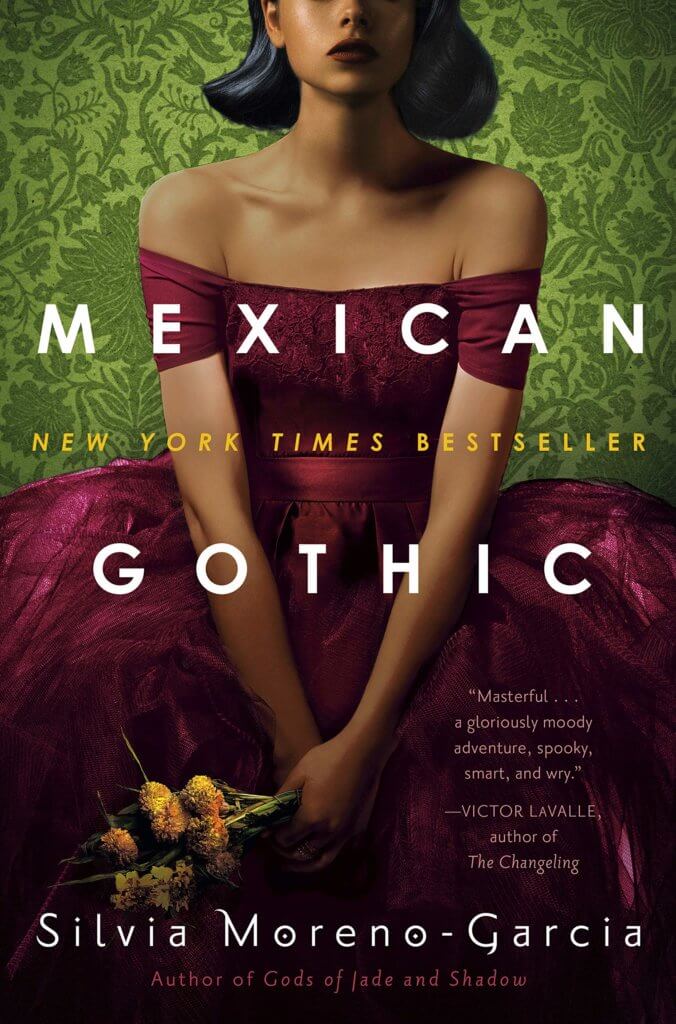Mexico, 1950. A young woman named Noemí Taboada receives word that her cousin Catalina Doyle has been acting strangely. Amongst other things, Catalina has been experiencing visions and is convinced that her husband Virgil is plotting to murder her. Noemí’s father suspects that this is merely a ploy for attention, but he is sufficiently concerned that he sends the person whom Catalina has been calling for: Noemí.
Mexican Gothic
Silvia Moreno-Garcia
Del Rey
June 30, 2020
Upon arriving at the Doyle household, Noemí finds that something strange is indeed happening. The clan into which Catalina has married is more than merely eccentric: it is outright sinister. Catalina herself speaks of strange phenomena, claiming to hear the voices of dead people in the walls telling her secrets. This could be the product of a fevered imagination, or it could be something else – and when Noemí witnesses the apparition of a woman with a glowing face haunting the house, she starts to realise the terrifying truth to her cousin’s claims.
Mexican Gothic harks back to a specific era in the development of popular Gothic novels – one that existed long after the genre’s eighteenth-century origins, but a few decades before vampire romance came to dominate. In the sixties and seventies, shelves of paperback retailers were lined with novels whose covers showed women (often in nightclothes and usually sporting immaculate hair) casting anxious glances behind her as while fleeing spooky buildings against the nighttime sky. The overlap in cover theme reflected an overlap in plot structure: the genre was built upon a narrative that was used time and time again because it struck a chord with the readership.
With Mexican Gothic, author Silvia Moreno-Garcia gives the genre of women-running-from-houses Gothic fiction a triumphant revival. All of the favourite beats are here: the young heroine invited to stay in a creepy house; the family with dark secrets; a family member who is insane, or thought to be insane; and various eerie goings-on that may or may not be psychological. The novel is far from a mindless rehash, however. Moreno-Garcia is not content to merely blow the dust off the old conventions and give them a new coat of polish; instead, she takes the time and effort to recraft every genre element that she touches, creating a new dark sculpture each time.
Her main way of doing so is by using the old Gothic standards as a way to explore the social tensions running throughout the story’s setting. The Doyles turn out to be advocates of eugenics and see themselves as superior specimens of humanity. Howard, Virgil’s father and patriarch of the Doyle clan, draws attention to how Noemí – who has Mazatec ancestry – is darker-skinned than Catalina; this leads to an awkward conversation about race:
“…Now tell me, Miss Taboada, do you believe as Mr. Vasconcelos does that it is the obligation, no, the destiny, of the people of Mexico to forge a new race that encompasses all races? A ‘cosmic’ race? A bronze race? This despite the research of Davenport and Steggerda?”
“You mean their work in Jamaica?”
“Splendid, Catalina was correct. You do have an interest in anthropology.”
“Yes,” she said. She did not wish to share more than that single word.
“What are your thoughts on the intermingling of superior and inferior types?” he asked, ignoring her discomfort.
Noemí felt the eyes of all the family members on her. Her presence was a novelty and an alteration to their patterns. An organism introduced into a sterile environment. They waited to hear what she revealed and to analyze her words. Well, let them see that she could keep her cool. She had experience dealing with irritating men. They did not fluster her. She had learned, by navigating cocktail parties and meals at restaurants, that showing any kind of reaction to their crude remarks emboldened them.
Noemí later finds rows of eugenics magazines in the Doyles’ library, prompting her to wonder if Howard “kept a pair of calipers to measure his guests’ skulls.” Gender, as well as race, turns out to be a bone of contention – although this is less of a shock to Noemí as her own parents are far from feminist. To her mother, “[g]irls were supposed to follow a simple life cycle, from debutante to wife. To study further would mean to delay this cycle, to remain a chrysalis inside a cocoon.” Meanwhile, her father “said she cared too much about her looks and parties to take school seriously, as if a woman could not do two things at once.” But then, such views would not have been outside the norm – as the novel reminds us, Mexican women were still unable to vote in 1950. The obsession with eugenics that Noemí encounters in her new home turns out to be a deeper, darker rot.
The Doyles embody a beloved Gothic archetype: the sinister family with strange traditions. No cursed Gothic family is complete without a dark history, and so Noemí’s exploration of the house puts her in contact with some long-buried secrets. The Doyle estate includes a disused mine, closed since the Mexican Revolution but previously the site of ethnic tensions, an epidemic and a violently-quashed strike. Macabre stories are attached to it, including rumours of mass graves. Noemí also hears the story of Ruth, Virgil Doyle’s elder sister, who went on a killing spree a week before her wedding, shooting her groom, multiple family members and finally herself.
Elsewhere, Howard Doyle reveals that he has had two wives: before Alice, who was shot by Ruth, he was married to a woman named Agnes who died of sickness while pregnant; the two women were sisters – and both were Howard’s cousins. During the course of the story, Noemí has dreams that show her glimpses of the past and reveal to her the truth behind the stories of Ruth, the mine, and Howard Doyle’s family history.
Still another mystery tied up with the Doyle home is a pervasive fungus that manifests as shifting mould and glowing mushrooms; this turns out to be one of the novel’s most inspired concepts. Moreno-Garcia draws upon multiple real-world analogues – the usage of entheogenic mushrooms in Mazatec culture; the fungus Massospora cicadina that sprouts within and gradually destroys the body of a cicada – to create something that serves as both major motif and central plot device. To say more would be to give away too much of the plot, but suffice to say that the bizarre properties of the fungus play an important role in the weird phenomena. This is novel – certainly, few would point to fungus as a particularly prominent element of Gothic fiction – yet also a natural fit. In a genre dealing with the eruption of dark, long-buried secrets onto the surface, fungus makes an apt metaphor.
Between its clear-headed understanding of genre mechanics, its astute depiction of social ills and its inspired fantasy concepts, Mexican Gothic assembles a perfect base for its narrative. All it needs to do is to drop Noemí into the middle, so that we can watch as she makes her way through her personal horror story. She runs into the sorts of hazards and hurdles that will be familiar to many a Gothic heroine (ranging from grotesque body-horror to the psychological terrors of predation and gaslighting) but which are seldom depicted with such raw vitality.
Mexican Gothic is at once otherworldly, and psychologically plausible; unnerving, and compulsively readable; familiar, and yet new. A genre may wither and die but Silvia Moreno-Garcia demonstrates how it can still be given the kiss of life.


